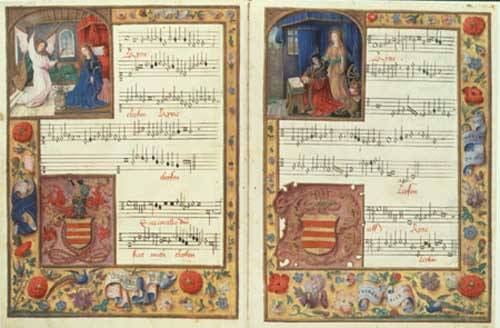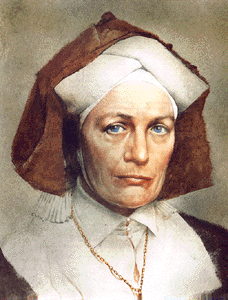The earliest composer in the West was Hildegard von Bingen (1098-1179). Born the tenth child of noble family, she was promised to the Church as a tithe (which means “tenth”). She was sent to the Benedictine monastery of Disibodenberg and took the veil at the age of 15. She became the abbess in 1136. She knew only the monastic life for many years and had almost no contact with the outside world save for a single window until the middle of her life when she left the monastery and established a convent in Rupertsburg near Bingen in 1147. She suffered from migraine headaches. Either the headaches themselves or the treatments caused her to have visions which she wrote down (I have reason to believe she may have taken treatments using ergot which contains LSD). She also wrote music and poetry around the 1150s and a morality play in 1151 called Ordo virtutum, the oldest known morality play. She was also an artist. She also wrote treatises on philosophy, medicine and science. She was a physician and healer—to many, a prophet (because her visions often foretold the future) and miracle-worker. She was also a skilled herbalist and an early botanist. She also invented her own coded language (one has to wonder how much she might have had to do with the Voynich manuscript). Pope Eugene III loved her song, Scivias (“Know the Ways of the Lord”), which he inherited from the venerated teacher, St. Bernard of Clairvaux, and read the words in public. This gave her special papal approval no other women and even few men enjoyed.
She founded another convent in Eibingen and taught her nuns about the special role of the feminine in divinity that she had seen in her visions. She taught them that women were the only fit template for the image of god since male involvement in the Immaculate Conception was non-existent but could never have happened without a woman. She would not allow her ladies to languish but made sure they were educated in science as well as religion. They learned such arts as painting and copying manuscripts including illuminating the margins. They were taught to read, write and sing music as well as learning musical instruments. They also learned to weave and tend to flocks of sheep and goats in order to be as self-sufficient as possible. Her convents even had piped-in water! She taught her nuns to bathe regularly in warm water at a time when bathing was actually seen as unhealthy! She also had the convents make their own beer which the nuns drank because Hildegard felt the water in its natural state was unsafe for consumption (she was right).
Her music was unlike anything else the Church was producing. For example, she did not write plainchant but in her own unique style which was highly original and well written. She was a known composer in her time when most written music was published anonymously:
Hildegard of Bingen, Spiritus Sanctus - YouTube

Hildegard of Bingen.

An example of Hildegard’s written music.
While women were forbidden by canon law to preach, Hildegard continued to lecture, publish works and as well as carry on a voluminous correspondence with popes, archbishops, rulers and ordinary clergy she had met. Her self-education must have been extensive, her intellect very high (she was regarded in her own time as a polymath) and her spirit fearless. She even opposed the Church when she gave permission for a revolutionary who had died to be buried at the Rupertsburg abbey cemetery in 1178. When the Church overruled her, she protested that the man’s sins were already absolved. The Church sent people to exhume the body. Hildegard had the grave markers removed prior to their arrival so that they would not be able to locate his grave. Angered, the canons placed the abbey under interdict meaning that, among other things, music was banned there. Hildegard vigorously protested saying that the banning of music was itself a sin but still she would not give in and identify the man’s grave. After some months, the Church gave up and lifted the interdict in March of 1179. In September of that year, Hildegard von Bingen passed from the world at the age of 81, a remarkably long life for a time when men died of “natural causes” in their 30s and 40s and few women lived long enough to see their 60s—a testament to her philosophy and practice of hygiene and healthy living. She was never officially made a saint but is often referred to as one.

Another likeness of Hildegard, a.k.a. Sybil of the Rhine.